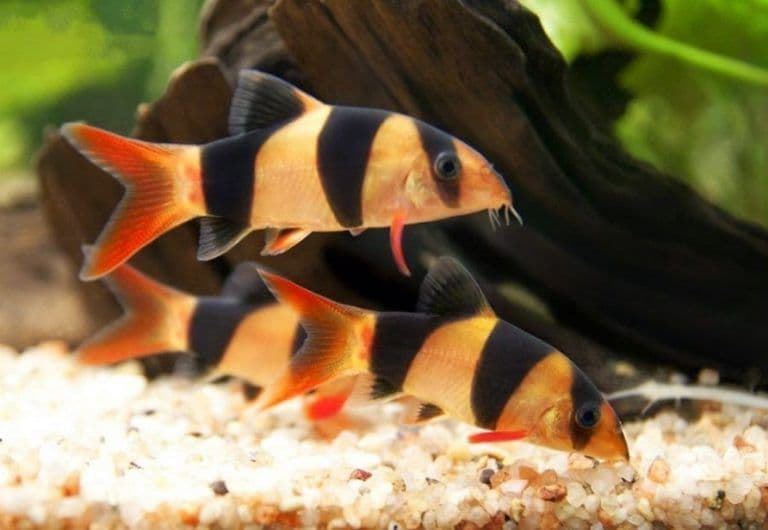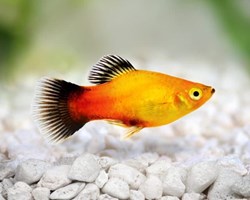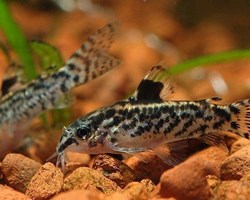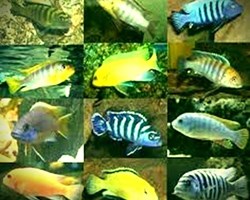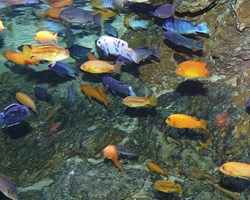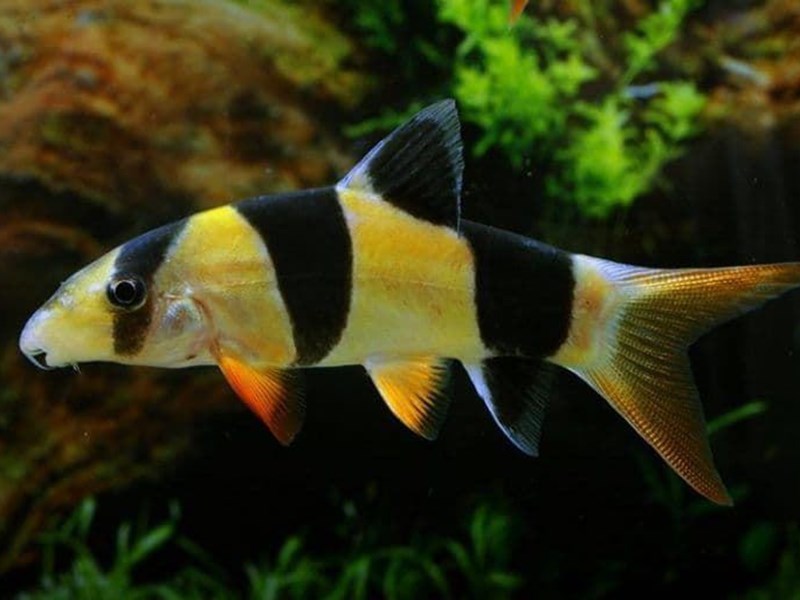
DESCRIPTION OF THE CLOWN BOTIA:
Scientific name: Chromobotia macracanthus
Common name: Botia Clown, Clown Loach, Botia Macracanthus, Botia Tigre
Aquarium size: 200 liters
Temperament: Calm and gregarious
Temperature: 24ºC to 30ºC
pH: 5.0 to 8.0
Diet: Omnivores
Length: 15 centimeters
The Botia Macracantha or clown botia (Bleeker, 1852) is undoubtedly one of the most beautiful and striking species that we can keep in a community aquarium of certain dimensions.
It is native to Indonesia, Borneo and Sumatra.
Its natural biotopes are made up of rivers, streams and lagoons and can be located in both calm waters and large currents.
The Clown Botia, also known as Botia Macracanthus, since this was previously its scientific name, is a fish of the Cobitid or Loach genus.
It is one of the best-known aquarium fish of its kind, perhaps because of its bright and attractive colors, although it is not the only interesting feature of this fish:
- It has nocturnal habits, it is quite disturbed by light, although less than other loaches.
- It can make clicking sounds, audible even outside the aquarium.
- It is a calm and sociable fish, which can live quietly sharing space with other species, it likes the lower part of the aquarium.
In the wild, these fish can measure up to 40 centimeters, but in an aquarium it is quite rare for them to reach that size, and it is common for their growth to slow down or stop when they reach 15 to 20 centimeters.
Some publications admit that sexual dimorphism is not known in captivity, it must be considered that these fish do not reach their "real" adult size in the aquarium.
Others point out that the females are somewhat thicker than the males, and that the males have a deeper fork in their caudal fin. This last point is more a theory than a proven fact.
Its body is elongated and laterally compressed, finished off with a very thick and strong caudal fin.
The mouth, which opens downwards, has four pairs of barbels.
Another very interesting morphological detail is the presence of an erectile spine under the eyes, which serve as a weapon against predators, and which can hurt us when handling it in the aquarium.
They have a bright yellow-orange coloration, crossed by three very well defined black bands, the first of which (oblique and less marked) crosses the eye, the central band is almost vertical, while the third band (also oblique) it is oriented in the opposite direction to the first and covers the dorsal fin and goes down to the abdomen.
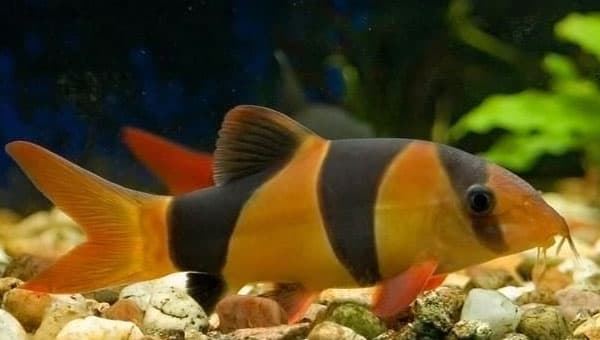
DISTRIBUTION AND HABITAT:
The Clown Botia is native to the Big Sunda Islands of Borneo and Sumatra.
It is known that there are genetic differences, depending on the island from which they come, and some scholars have suggested that a detailed study be carried out, to determine if they are different species.
Their natural habitat changes depending on the time of year and also depending on their age.
They usually live in the main channels of the rivers, but they go up the smaller channels to spawn, during the wet season of the year, when some areas are flooded.
The young specimens usually remain for several months, in the areas where the Botia Payaso fish reproduces, while the adults return to the main rivers after spawning.
The places that it usually inhabits in its adult state are soft water rivers, with areas of swampy forest, with a large amount of vegetation that causes thick shade.
The bottom contains substrate with large amounts of decaying vegetation, tree roots, logs, etc. These currents are usually very slow.
Its great distribution makes the aquatic parameters vary a little to maintain them. However, as a general rule, they prefer warm waters around 27ºC, slightly acidic to neutral, soft and moderately hard.
Its body is cylindrical, elongated and thick. Its main color is yellow divided by three vertical black stripes. Its pectoral and caudal fins have reddish tones.
They belong to the Cobitidae family that includes about a hundred species.
The Botias Macracanthas are not friends with very intense lighting, so they will always seek refuge among the vegetation and decorative objects in the lower part of the aquarium.
Placing floating plants will allow us more time to observe these striking fish.
They are very active at dusk and search for food on the substrate with the help of their sensitive barbels, similar to those of Corydoras, which we can locate in their mouths.
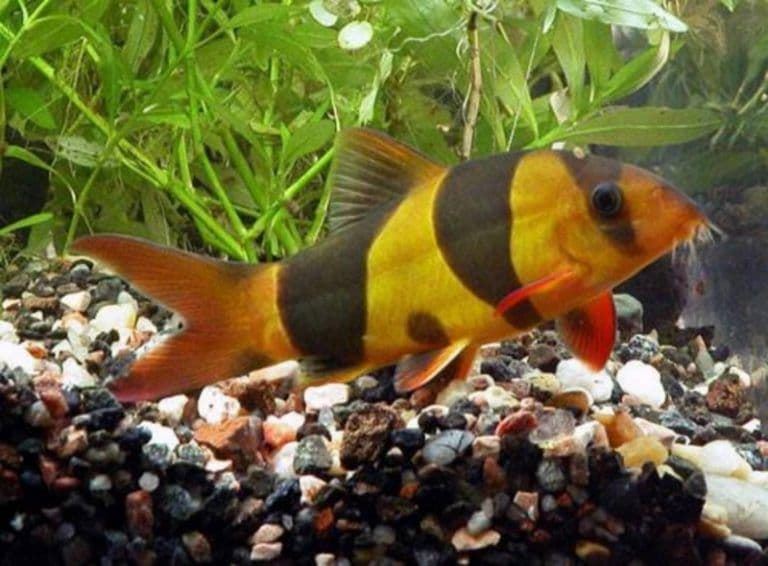
THE NUTRITION OF THE CLOWN BOTIA:
Their diet in the wild is made up of small crustaceans, snails, insect larvae, and worms.
It needs a certain vegetable contribution that it obtains directly from the new shoots of aquatic plants and from their softer parts.
It is a species included among those known as biological controllers by helping us with snail pests and their spawning.
Accepts all kinds of food including flakes and freeze-dried but it is more convenient because it can reach the area where our animals are.
Fast sinking tablets and pellets can be the basis of food.
So that they do not bite the leaves of the plants, it is advisable to offer them regularly pills with a vegetable contribution.
Preferably choose plants with hard leaves.
We can distinguish the attack on our plants because we can clearly see the holes they make in the leaves.
It also willingly accepts any type of frozen food, especially red mosquito larvae and homemade porridge.
His habit of vacuuming animal will benefit the maintenance of the substrate by ingesting the remains of food that have been left unconsumed.
In many places it is said that the Clown Botia is omnivorous and indeed, it will eat almost anything, but they are mainly carnivorous fish.
For proper development, growth and to avoid any type of disease, it is advisable to follow a varied diet, which can include quality dry products, live or frozen worms, Tubifex, Artemia, as well as fresh fruits and vegetables.
Some aquarists create their own homemade foods, mixing pieces of cucumber, melon, spinach, zucchini, etc, together with gelatin. They seem to be a highly recommended dietary supplement.

BEHAVIOR AND COMPATIBILITY:
It is a gregarious species that likes to live in the company of fellow members of its species. They are not great swimmers so they will spend most of their time perched on their fins.
It has the nickname of freshwater clownfish due to its particular coloration, just like the marine Amphiprions.
They are peaceful, so their maintenance is highly recommended for any community freshwater aquarium.
It is preferable to keep this peaceful species with Asian fish although it can be kept with a large number of species including Corydoras with which they can form a school.
Due to their habit of living attached to the substrate, it is not convenient to keep them with species of American or African cichlids that will compete with them for the territory.
Clown Botia have sharp spines in the gill area that they use for self-defense.
We must be careful when handling them with the brackish so that they do not get stuck and suffer some tear.
Clown loaches make a perceptible sound from outside the aquarium.
Although it is not a particularly aggressive fish (rather calm), you must always bear in mind that the Clown Botia is a fish that acquires a good size and usually has a very active behavior and is less shy than other Cobitids.
For example, fish that typically have ornamental tails, such as guppies, bettas, or some cichlids, can get their fins bitten off.
In general, it is recommended to include with peaceful cyprinids, it can also share space with many catfish.
Their behavior is gregarious, so it is recommended to keep groups of no less than 5 or 6 individuals, in which quite complex social hierarchies are formed.
Compatible fish without restrictions:
- Silver Dollar.
- Climb.
- Ax Fish.
- Tiger Barb.
- Ramirezi.
- Nun fish.
- Goldfish.
- Discus fish.
- Apple Snail.
- Molly.
- Bubble eyed fish.
- Rainbow.
- Telescope fish.
- Guppies.
- Pearl Gourami.
- Harlequin fish.
- Zebra fish.
- Neon tetra fish.
- Female betta.
- Cardinal fish.
- Corydoras.
- Ancistrus.
Fish compatible with restrictions:
- Koi carp.
- Otocinclus.
- Drunken Fish.
- Killi fish.
- Platy.
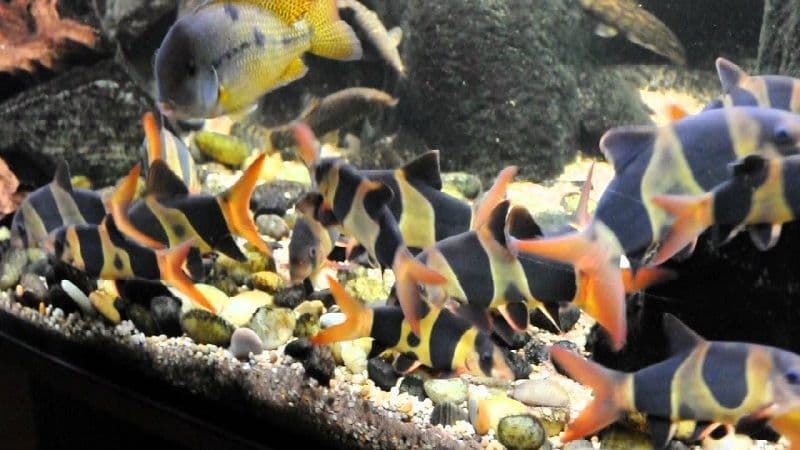
CARE OF THE AQUARIUM FOR THE CLOWN BOTIA:
We must consider a tank of at least 100 liters to keep Botias.
It must be sufficiently planted and have logs and rocks that offer them hiding places.
The filtration system does not have to be oversized, it will be worth the one adjusted to the Biological load of the aquarium.
In the aquarium we can feed the Botia macracantha in a simple way.
When choosing our Boots we must pay special attention to the ventral area.
Those animals with a sunken belly should be discarded as it is a symptom of the presence of parasites.
It is not common, but in times of stress it can jump out of the aquarium, which is why it is more advisable to install facilities with a lid.
Due to their growth and that they prefer to be in small groups, the recommended aquarium size is 200 liters.
The recommended temperature can range between 24ºC and 30ºC, with a pH between 5.0 and 8.0, and a water hardness between 50 and 120 mg/L.
The aquarium should have a bottom of sand or fine gravel, with roots and stones that can serve as a refuge.
They are very curious and like to inspect any hole or crack, so care must be taken with the shelters, that they are not too small and that they do not have sharp edges.
As for plants, they like well-planted aquariums, where they can easily find shelter.
Because moderate lighting is recommended, the best plants to introduce are Java Fern, Java Moss, or Anubias.
They require aquariums with little water movement, very well oxygenated and that do not accumulate organic waste.
CLOWN BOTIA DISEASES:
They are not delicate fish or sensitive to diseases, although they can develop the common ones in all community aquariums.
There are two exceptions regarding diseases that we must take into account.
WHITE POINT:
They are sensitive to white spot (Ichthyophthirius multifilis), which can be triggered by any stress situation or drop in temperature, and to velvet disease (Oodinium).
They tend to respond well to treatments and usually end up eradicating the disease without treatment if the balance in the aquarium is restored.
It is very good practice to leave the aquarium without light for 24 hours after the introduction of our new animals so that they calm down and reduce stress so that we will not reduce their natural defenses.
In Glu Glu Pet you can find Clown Botias between 4 and 7 cm.
We must bear in mind that although in the aquarium they will never reach sizes of 30 cm, which is what they can develop, they are a species of certain dimensions, so we must plan their maintenance based on their adult size and not the time of their purchase. .
The dimensions of the aquarium mark the final size of our specimens.
In captivity they do not usually exceed sizes of 12-15 cm.
There are originally in the north of Borneo some populations of giant Botia macracantha that can reach sizes in the aquarium of up to 25 cm.
Its tonality is more matte than the small Clown Boots.
THE REPRODUCTION OF THE CLOWN BOTIA:
The reproduction of the Botia clown is complex and if it is true that it has been achieved on occasions, it is not a general rule.
It does not present apparent sexual dimorphism.
They take several years to reach sexual maturity and in the aquarium, they do not reach their full development as adults.
In nature, these fish reproduce by migrating from their usual place, reaching small river channels and flood plains.
In the aquarium these conditions cannot be reproduced and therefore, they are not fish that reproduce in a community aquarium.
